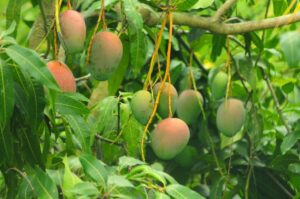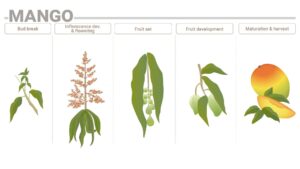To improve local mango (Mangifera inidica L.) production, the Bangladesh Agricultural University conducted a field trial during the period from September 2006 to July 2007. Aim was to study the effect of KNO3 and urea on regulation of flowering and harvesting time, and increasing yield and quality of the fruits. Nine year old plants of the cultivar ‘Amrapali’ were grown with a plant spacing of 5 m x 5 m. The experiment was laid out in a Randomized Complete Block Design with 3 replications. The six treatments included a control (water spray), potassium nitrate at three rates (4%, 6% and 8% in the foliar spray solution) and urea at two rates (2% and 4% in the foliar spray solution). Tween 80 was added as a surfactant (3 drops/L spray solution). All foliar sprays were applied once, on 15 November 2006, one month before the appearance of the first panicle.
A great number of parameters regarding vegetative and generative development, yield and fruit quality were recorded.
Observations on the leaf, shoot and panicle development, showed that foliar application of both urea and KNO3 at 4% in foliar spray increased growth compared to the control. At this dose, urea mostly increased the vegetative development, with the most profound effect on leaf area, whereas KNO3 (4% in foliar spray) was most effective in increasing the size of the panicle and number of secondary branches on the panicle.
Potassium nitrate advanced flowering: Panicles on trees sprayed with 4% KNO3 appeared 17 days earlier, compared to the control treatment. Potassium nitrate also increased the panicle number: At 4% KNO3 in the foliar spray, the highest number of panicles per plant (220,7) was counted, more than double the count on control trees (107,7). Maximum initial fruit set per panicle was recorded for the 6% KNO3 foliar treatment (19,9 fruit/panicle) followed by 4% KNO3 (17,3 fruit/panicle) and 4% urea (17,3 fruit/panicle). This was again an improvement on the control, with an average initial fruit set of 6,5 fruits per panicle. The number of fruits retained per panicle at harvest was highest after foliar application of 4% KNO3 (1,6 fruit/panicle) or 4% urea (1,4 fruit/panicle) compared to 0,7 in the control.
Harvest was advanced not more than 5 days on trees sprayed with potassium nitrate or urea at all rates, compared to the control. The higher number of panicles and fruit set observed earlier in the season, had developed at harvest time to the highest number of harvested fruits per plant on trees sprayed with 4% KNO3 (136,7 fruits/plant) compared to the control (62,7 fruits /plant) or the second highest (108,3 fruits /plant) after spray with 4% urea. Weight per fruit and dry matter content of the fruit was highest after the 4% KNO3 and 4% urea sprays, and all KNO3 and urea foliar treatments resulted in higher vitamin C and total sugar content of the fruits compared to the water spray treatment. Moreover, the average shelf life of the mango fruits from trees sprayed with either urea or KNO3 at 4% in foliar spray was increased by more than two days compared to the control.
Spraying potassium nitrate at 4% also led to the highest yield (23,1 kg fruit/plant). All the foliar treatments improved the yield compared to the minimal yield of 9,1 kg fruit/plant in the water sprayed control (Figure 1).
The authors conclude that foliar application of KNO3 and urea at 4% in the foliar application both improved yield as well as quality of mango fruit. Sprays had little effect on the manipulation of harvesting time.

Figure 1. Effect of foliar treatments with different concentrations of KNO3 and urea on the yield of mango.



